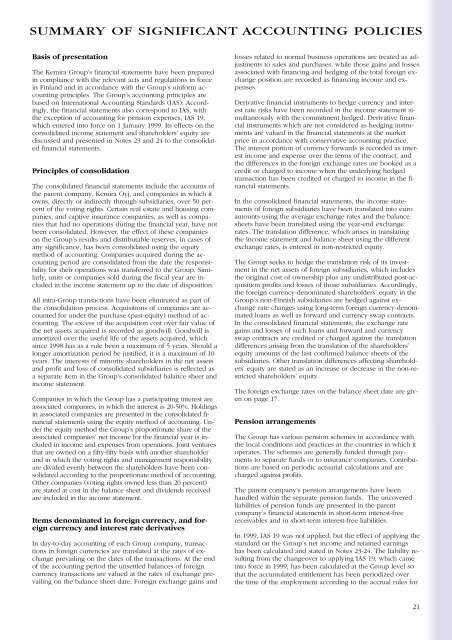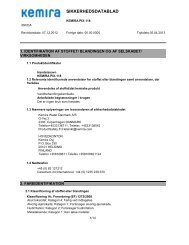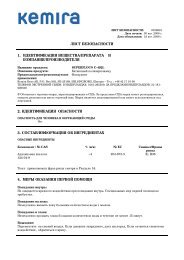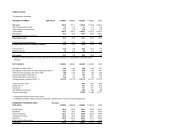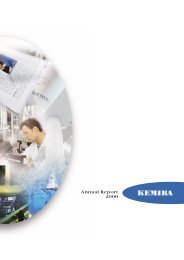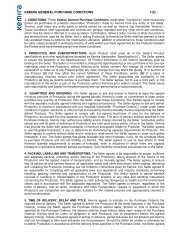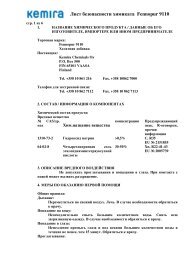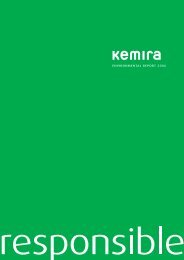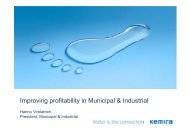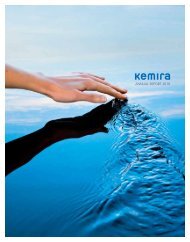Annual Report 1999 - Kemira
Annual Report 1999 - Kemira
Annual Report 1999 - Kemira
Create successful ePaper yourself
Turn your PDF publications into a flip-book with our unique Google optimized e-Paper software.
SUMMARY OF SIGNIFICANT ACCOUNTING POLICIES<br />
Basis of presentation<br />
The <strong>Kemira</strong> Group’s financial statements have been prepared<br />
in compliance with the relevant acts and regulations in force<br />
in Finland and in accordance with the Group’s uniform accounting<br />
principles. The Group’s accounting principles are<br />
based on International Accounting Standards (IAS). Accordingly,<br />
the financial statements also correspond to IAS, with<br />
the exception of accounting for pension expenses, IAS 19,<br />
which entered into force on 1 January <strong>1999</strong>. Its effects on the<br />
consolidated income statement and shareholders’ equity are<br />
discussed and presented in Notes 23 and 24 to the consolidated<br />
financial statements.<br />
Principles of consolidation<br />
The consolidated financial statements include the accounts of<br />
the parent company, <strong>Kemira</strong> Oyj, and companies in which it<br />
owns, directly or indirectly through subsidiaries, over 50 percent<br />
of the voting rights. Certain real estate and housing companies,<br />
and captive insurance companies, as well as companies<br />
that had no operations during the financial year, have not<br />
been consolidated. However, the effect of these companies<br />
on the Group’s results and distributable reserves, in cases of<br />
any significance, has been consolidated using the equity<br />
method of accounting. Companies acquired during the accounting<br />
period are consolidated from the date the responsibility<br />
for their operations was transferred to the Group. Similarly,<br />
units or companies sold during the fiscal year are included<br />
in the income statement up to the date of disposition.<br />
All intra-Group transactions have been eliminated as part of<br />
the consolidation process. Acquisitions of companies are accounted<br />
for under the purchase (past-equity) method of accounting.<br />
The excess of the acquisition cost over fair value of<br />
the net assets acquired is recorded as goodwill. Goodwill is<br />
amortized over the useful life of the assets acquired, which<br />
since 1998 has as a rule been a maximum of 5 years. Should a<br />
longer amortization period be justified, it is a maximum of 10<br />
years. The interests of minority shareholders in the net assets<br />
and profit and loss of consolidated subsidiaries is reflected as<br />
a separate item in the Group’s consolidated balance sheet and<br />
income statement.<br />
Companies in which the Group has a participating interest are<br />
associated companies, in which the interest is 20-50%. Holdings<br />
in associated companies are presented in the consolidated financial<br />
statements using the equity method of accounting. Under<br />
the equity method the Group’s proportionate share of the<br />
associated companies’ net income for the financial year is included<br />
in income and expenses from operations. Joint ventures<br />
that are owned on a fifty-fifty basis with another shareholder<br />
and in which the voting rights and management responsibility<br />
are divided evenly between the shareholders have been consolidated<br />
according to the proportionate method of accounting.<br />
Other companies (voting rights owned less than 20 percent)<br />
are stated at cost in the balance sheet and dividends received<br />
are included in the income statement.<br />
Items denominated in foreign currency, and foreign<br />
currency and interest rate derivatives<br />
In day-to-day accounting of each Group company, transactions<br />
in foreign currencies are translated at the rates of exchange<br />
prevailing on the dates of the transactions. At the end<br />
of the accounting period the unsettled balances of foreign<br />
currency transactions are valued at the rates of exchange prevailing<br />
on the balance sheet date. Foreign exchange gains and<br />
losses related to normal business operations are treated as adjustments<br />
to sales and purchases, while those gains and losses<br />
associated with financing and hedging of the total foreign exchange<br />
position are recorded as financing income and expenses.<br />
Derivative financial instruments to hedge currency and interest<br />
rate risks have been recorded in the income statement simultaneously<br />
with the commitment hedged. Derivative financial<br />
instruments which are not considered as hedging instruments<br />
are valued in the financial statements at the market<br />
price in accordance with conservative accounting practice.<br />
The interest portion of currency forwards is recorded as interest<br />
income and expense over the terms of the contract, and<br />
the differences in the foreign exchange rates are booked as a<br />
credit or charged to income when the underlying hedged<br />
transaction has been credited or charged to income in the financial<br />
statements.<br />
In the consolidated financial statements, the income statements<br />
of foreign subsidiaries have been translated into euro<br />
amounts using the average exchange rates and the balance<br />
sheets have been translated using the year-end exchange<br />
rates. The translation difference, which arises in translating<br />
the income statement and balance sheet using the different<br />
exchange rates, is entered in non-restricted equity.<br />
The Group seeks to hedge the translation risk of its investment<br />
in the net assets of foreign subsidiaries, which includes<br />
the original cost of ownership plus any undistributed post-acquisition<br />
profits and losses of those subsidiaries. Accordingly,<br />
the foreign currency-denominated shareholders’ equity in the<br />
Group’s non-Finnish subsidiaries are hedged against exchange<br />
rate changes using long-term foreign currency-denominated<br />
loans as well as forward and currency swap contracts.<br />
In the consolidated financial statements, the exchange rate<br />
gains and losses of such loans and forward and currency<br />
swap contracts are credited or charged against the translation<br />
differences arising from the translation of the shareholders’<br />
equity amounts of the last confirmed balance sheets of the<br />
subsidiaries. Other translation differences affecting shareholders’<br />
equity are stated as an increase or decrease in the non-restricted<br />
shareholders’ equity.<br />
The foreign exchange rates on the balance sheet date are given<br />
on page 17.<br />
Pension arrangements<br />
The Group has various pension schemes in accordance with<br />
the local conditions and practices in the countries in which it<br />
operates. The schemes are generally funded through payments<br />
to separate funds or to insurance companies. Contributions<br />
are based on periodic actuarial calculations and are<br />
charged against profits.<br />
The parent company’s pension arrangements have been<br />
handled within the separate pension funds. The uncovered<br />
liabilities of pension funds are presented in the parent<br />
company’s financial statements in short-term interest-free<br />
receivables and in short-term interest-free liabilities.<br />
In <strong>1999</strong>, IAS 19 was not applied, but the effect of applying the<br />
standard on the Group’s net income and retained earnings<br />
has been calculated and stated in Notes 23-24. The liability resulting<br />
from the changeover to applying IAS 19, which came<br />
into force in <strong>1999</strong>, has been calculated at the Group level so<br />
that the accumulated entitlement has been periodized over<br />
the time of the employment according to the accrual rules for<br />
21


